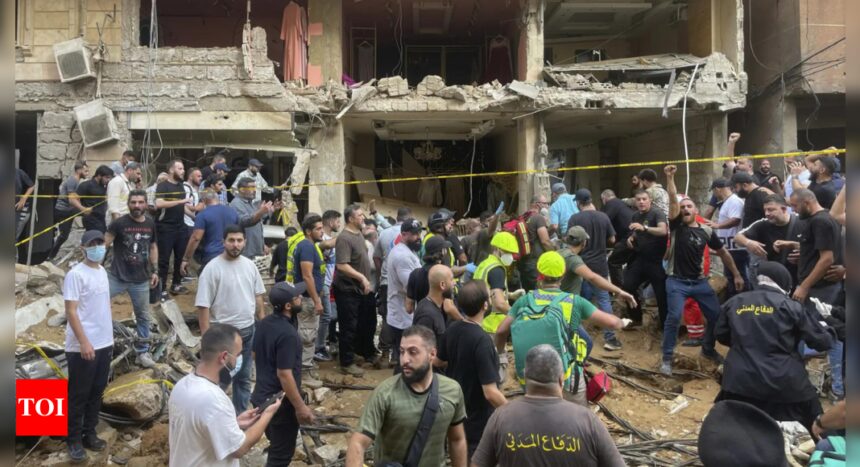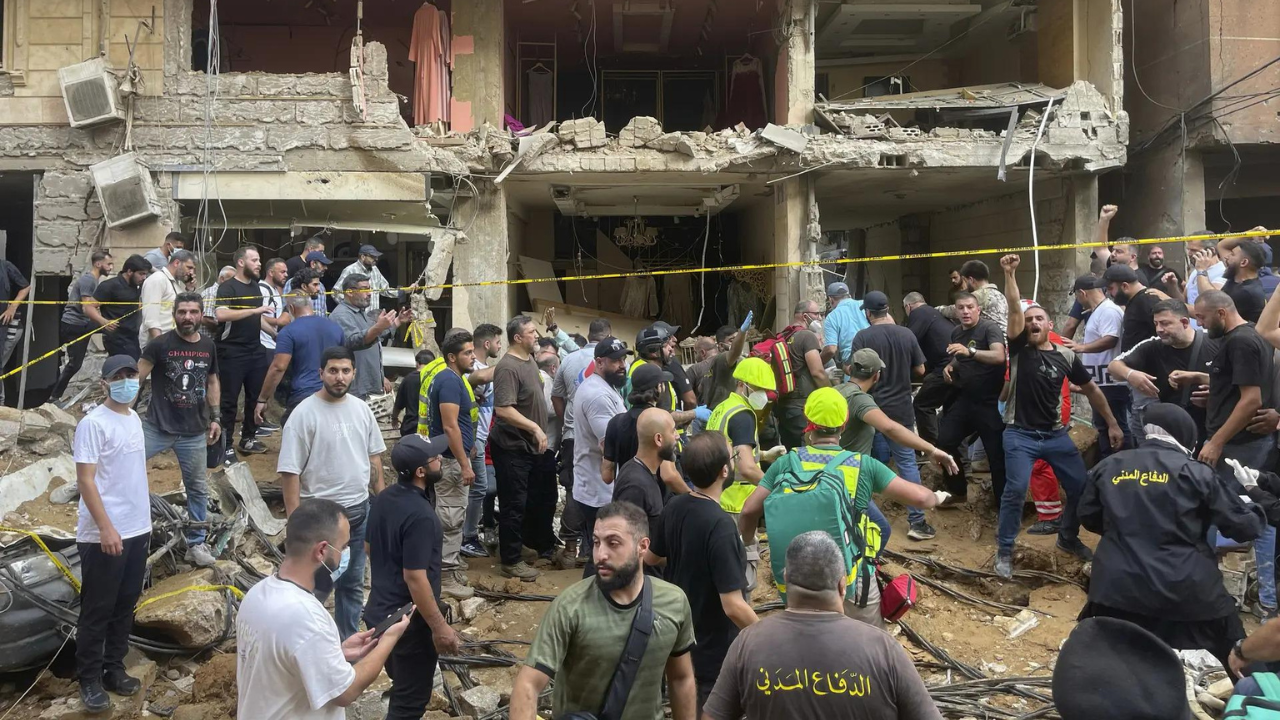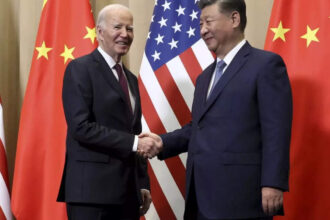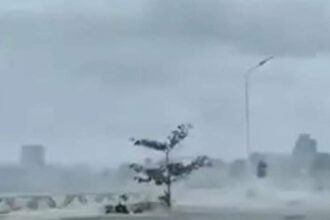Israel launched airstrikes on targets across southern Lebanon, killing nearly 500 people in one of the deadliest days of fighting in nearly two decades and fanning fears of all-out war.
Some 1,650 people were wounded in the strikes and about 100 women and children were among the dead, the Lebanese health ministry said. Israeli officials said many of those killed were members of the Lebanese militia Hezbollah, and argued that the group had placed rocket launchers in private homes.
The strikes were a major escalation just days after an attack in which pagers and walkie-talkies owned by Hezbollah members exploded. Israel didn’t take credit for that campaign but the group blamed Prime Minister Benjamin Netanyahu’s government.
“I want to clarify Israel’s policy: we do not wait for the threat, we are ahead of it,” Netanyahu said Monday. He predicted “complicated days” ahead.
One Israeli military official said the country is focused on an aerial campaign to degrade Hezbollah’s military capabilities, suggesting a major ground invasion was not imminent.
Israel Intensifies Strikes Into Lebanon | Israeli air campaign in Lebanon on Sept. 21–22
But a senior US official, who spoke to reporters on condition of anonymity, said it’s important to take seriously Israel’s preparations for an invasion and that the US is focused on breaking the escalatory cycle.
In any event, it was the deadliest day of strikes since the 2006 war between Israel and Hezbollah. The strikes occurred as world leaders including Netanyahu were descending upon New York for the annual high-level meeting of the United Nations General Assembly, where Israel’s war against Hamas in the Gaza Strip was set to be a focus.
The US is urging restraint and Secretary of Defense Lloyd Austin has spoken to Israeli counterpart Yoav Gallant several times in recent days, stressing the need for a diplomatic solution.
The two sides have been exchanging cross-border rocket fire almost daily since Israel’s war with Hamas erupted last October, but the conflict has stepped up in the past week.
The US will send a “small number” of additional troops to the Middle East, Pentagon spokesman Pat Ryder said without elaborating. NBC News reported the military personnel may be ready to help Americans evacuate from Lebanon, adding the USS Harry S. Truman aircraft carrier group could be sent to the region to augment the American military presence.
The State Department warned Americans in an updated advisory dated Sept. 21 against traveling to Lebanon and said its embassy “may not be able to assist US citizens who choose to remain.” The department also urged US citizens to depart Lebanon via commercial options while they are still available.
Netanyahu has said he would prefer using diplomacy to stop Hezbollah’s attacks, but such efforts are failing. His cabinet made the return of tens of thousands of civilians displaced from Israel’s north by the threat of attacks a primary war objective last week, while Gallant has said the military’s focus should shift from Gaza and Hamas to the northern front and Hezbollah.
Both Hezbollah and Hamas are sponsored by Iran and considered terrorist organizations by the US.
In a video message to the Lebanese people, Netanyahu added: “The IDF has warned you to get out of harm’s way. I urge you – take this warning seriously.”
In northern Israel, hundreds of thousands of people rushed to bomb shelters after 250 projectiles were fired early Monday. Hezbollah has access to a new type of rocket that can reach as far as 100 kilometers (62 miles) and carry 170 kilograms of explosives in its warhead, the organization said on its Telegram channel over the weekend.
Hezbollah said it had targeted Israeli army sites north of Haifa as sirens sounded, including in civilian areas. Israeli medics said eight people were wounded in northern Israel as a result of the Hezbollah assault. Israeli police reported a house being hit and rockets falling in several places in the Lower Galilee.
In New York, Danny Danon, Israel’s UN ambassador, said in an interview that “Hezbollah has placed rocket launchers in private homes and other civilian facilities” and Israel had urged those nearby “to move away from those locations.”
Netanyahu is scheduled to address the General Assembly this week, though his travel itinerary hasn’t yet been finalized.
Danon said Netanyahu was scheduled to land in the US on Thursday morning, “speak at the UN on Friday morning and to head back to Israel Saturday night. Now, it can change, because we will follow the events in Israel.”
Until last week, Israel and Hezbollah largely focused their strikes on areas near the border. Yet Israel has grown increasingly frustrated with its inability to stop Hezbollah’s missile and drone attacks.
On Tuesday and Wednesday, Hezbollah and Lebanon blamed Israel for blowing up thousands of pagers and walkie talkies mostly used by members of the group. The two-day operation in Lebanon killed at least 39 people, including civilians and children, and injured thousands.
Lebanon’s Prime Minister Najib Mikati called on the UN and world powers to act quickly to stop Israel and Hezbollah “falling into the unknown.”
Hezbollah is a Shiite militant organization that, like Hamas, Iran has trained and funded. It is considered the most powerful non-state force in the Middle East, with tens of thousands of missiles and fighters at its disposal. It’s also a political party with substantial support in Lebanon.
Also on Monday, an Israeli military spokesperson said it’s possible Hamas chief Yahya Sinwar has been wounded or killed in air strikes on Gaza, after local media reported he has been incommunicado.
“Regarding what has surfaced over the last day about Sinwar, I do not rule it out nor do I confirm it,” added the spokesperson, Daniel Hagari.
The Israeli government says Sinwar masterminded the Oct. 7 attack on Israel that triggered the war in Gaza. Last month, he was promoted to succeed the group’s political chief, Ismail Haniyeh, who was assassinated in Tehran, and is now the point-man for long-deadlocked talks mediated by the US, Qatar and Egypt.
The US has said that a cease-fire in Gaza will help calm regional tensions. Israel’s government says it cannot wait for a truce in the Palestinian territory before neutering the threat of Hezbollah.
Hamas killed 1,200 people and took 250 hostage with its assault last Oct. 7. Israel’s subsequent air and ground offensive has killed more than 41,000 Palestinians in Gaza, according to the Hamas-run health ministry, which doesn’t differentiate between combatants and civilians.
Some 1,650 people were wounded in the strikes and about 100 women and children were among the dead, the Lebanese health ministry said. Israeli officials said many of those killed were members of the Lebanese militia Hezbollah, and argued that the group had placed rocket launchers in private homes.
The strikes were a major escalation just days after an attack in which pagers and walkie-talkies owned by Hezbollah members exploded. Israel didn’t take credit for that campaign but the group blamed Prime Minister Benjamin Netanyahu’s government.
“I want to clarify Israel’s policy: we do not wait for the threat, we are ahead of it,” Netanyahu said Monday. He predicted “complicated days” ahead.
One Israeli military official said the country is focused on an aerial campaign to degrade Hezbollah’s military capabilities, suggesting a major ground invasion was not imminent.
Israel Intensifies Strikes Into Lebanon | Israeli air campaign in Lebanon on Sept. 21–22
But a senior US official, who spoke to reporters on condition of anonymity, said it’s important to take seriously Israel’s preparations for an invasion and that the US is focused on breaking the escalatory cycle.
In any event, it was the deadliest day of strikes since the 2006 war between Israel and Hezbollah. The strikes occurred as world leaders including Netanyahu were descending upon New York for the annual high-level meeting of the United Nations General Assembly, where Israel’s war against Hamas in the Gaza Strip was set to be a focus.
The US is urging restraint and Secretary of Defense Lloyd Austin has spoken to Israeli counterpart Yoav Gallant several times in recent days, stressing the need for a diplomatic solution.
The two sides have been exchanging cross-border rocket fire almost daily since Israel’s war with Hamas erupted last October, but the conflict has stepped up in the past week.
The US will send a “small number” of additional troops to the Middle East, Pentagon spokesman Pat Ryder said without elaborating. NBC News reported the military personnel may be ready to help Americans evacuate from Lebanon, adding the USS Harry S. Truman aircraft carrier group could be sent to the region to augment the American military presence.
The State Department warned Americans in an updated advisory dated Sept. 21 against traveling to Lebanon and said its embassy “may not be able to assist US citizens who choose to remain.” The department also urged US citizens to depart Lebanon via commercial options while they are still available.
Netanyahu has said he would prefer using diplomacy to stop Hezbollah’s attacks, but such efforts are failing. His cabinet made the return of tens of thousands of civilians displaced from Israel’s north by the threat of attacks a primary war objective last week, while Gallant has said the military’s focus should shift from Gaza and Hamas to the northern front and Hezbollah.
Both Hezbollah and Hamas are sponsored by Iran and considered terrorist organizations by the US.
In a video message to the Lebanese people, Netanyahu added: “The IDF has warned you to get out of harm’s way. I urge you – take this warning seriously.”
In northern Israel, hundreds of thousands of people rushed to bomb shelters after 250 projectiles were fired early Monday. Hezbollah has access to a new type of rocket that can reach as far as 100 kilometers (62 miles) and carry 170 kilograms of explosives in its warhead, the organization said on its Telegram channel over the weekend.
Hezbollah said it had targeted Israeli army sites north of Haifa as sirens sounded, including in civilian areas. Israeli medics said eight people were wounded in northern Israel as a result of the Hezbollah assault. Israeli police reported a house being hit and rockets falling in several places in the Lower Galilee.
In New York, Danny Danon, Israel’s UN ambassador, said in an interview that “Hezbollah has placed rocket launchers in private homes and other civilian facilities” and Israel had urged those nearby “to move away from those locations.”
Netanyahu is scheduled to address the General Assembly this week, though his travel itinerary hasn’t yet been finalized.
Danon said Netanyahu was scheduled to land in the US on Thursday morning, “speak at the UN on Friday morning and to head back to Israel Saturday night. Now, it can change, because we will follow the events in Israel.”
Until last week, Israel and Hezbollah largely focused their strikes on areas near the border. Yet Israel has grown increasingly frustrated with its inability to stop Hezbollah’s missile and drone attacks.
On Tuesday and Wednesday, Hezbollah and Lebanon blamed Israel for blowing up thousands of pagers and walkie talkies mostly used by members of the group. The two-day operation in Lebanon killed at least 39 people, including civilians and children, and injured thousands.
Lebanon’s Prime Minister Najib Mikati called on the UN and world powers to act quickly to stop Israel and Hezbollah “falling into the unknown.”
Hezbollah is a Shiite militant organization that, like Hamas, Iran has trained and funded. It is considered the most powerful non-state force in the Middle East, with tens of thousands of missiles and fighters at its disposal. It’s also a political party with substantial support in Lebanon.
Also on Monday, an Israeli military spokesperson said it’s possible Hamas chief Yahya Sinwar has been wounded or killed in air strikes on Gaza, after local media reported he has been incommunicado.
“Regarding what has surfaced over the last day about Sinwar, I do not rule it out nor do I confirm it,” added the spokesperson, Daniel Hagari.
The Israeli government says Sinwar masterminded the Oct. 7 attack on Israel that triggered the war in Gaza. Last month, he was promoted to succeed the group’s political chief, Ismail Haniyeh, who was assassinated in Tehran, and is now the point-man for long-deadlocked talks mediated by the US, Qatar and Egypt.
The US has said that a cease-fire in Gaza will help calm regional tensions. Israel’s government says it cannot wait for a truce in the Palestinian territory before neutering the threat of Hezbollah.
Hamas killed 1,200 people and took 250 hostage with its assault last Oct. 7. Israel’s subsequent air and ground offensive has killed more than 41,000 Palestinians in Gaza, according to the Hamas-run health ministry, which doesn’t differentiate between combatants and civilians.
Source : Times of India









